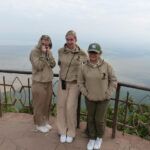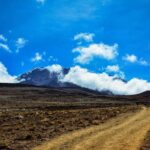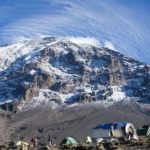One might be surprised to learn that the remnants of one of the oldest known human settlements were found in Tanzania, dating back almost two million years. This East African nation boasts a rich tapestry of history that extends far beyond its ancient tribes, making it a cradle of civilization. The legacy of these early inhabitants forms a fascinating prelude to Tanzania’s more recent historical developments.
Tanzania’s path to independence is equally riveting, characterized by a struggle that culminated in victory on December 9, 1961. Figures like Julius Nyerere played pivotal roles, guiding the nation towards self-governance in an era when African nations were intensely battling colonial rule. The post-independence period saw significant socio-economic changes, further marking Tanzania’s spot in the annals of history as a beacon of African resilience and progress.
The Rich Tapestry of Tanzania’s Early Civilizations
Tanzania’s ancient landscapes hold a treasure trove of human history. The Oldupai Gorge, often called the “Cradle of Mankind,” has yielded fossils dating back nearly two million years. Archaeologists have unearthed stone tools and early human remains, painting a vivid picture of life during prehistoric times. These findings provide critical insights into the evolution of our early ancestors. It’s a testament to Tanzania’s significant role in human development.
Beyond the stone tools, cave paintings found inside Kondoa rock shelters offer glimpses of early human creativity. These artworks, created thousands of years ago, depict hunting scenes, animals, and rituals. Their vivid colors and intricate designs captivate the imagination. They reveal much about the beliefs and daily lives of their creators. Through these images, we can connect with the humans of Tanzania’s ancient past.
Early civilizations in Tanzania also developed unique agricultural practices. Evidence shows that around 5000 years ago, people began farming and domesticating animals. With fertile land and favorable climate, they cultivated crops like sorghum and millet. Such advancements contributed to the region’s economic and social complexity. These early Tanzanians laid the groundwork for the agricultural traditions still present today.
Trade routes also highlight Tanzania’s early economic influence. The Swahili Coast became a hub for trade between Africa, Asia, and the Middle East. Traders exchanged goods like ivory, gold, and spices, enriching the local culture and economy. This exchange facilitated not just material goods but also ideas and traditions. Thus, Tanzania’s early civilizations were pivotal in shaping the rich cultural mosaic we see today.
Exploring the Roots of Human History in Oldupai Gorge
Oldupai Gorge, located in northern Tanzania, is often called the “Cradle of Mankind.” This area has revealed some of the earliest human fossils and tools, dating back over two million years. Archaeologist Mary Leakey unearthed the famous footprints of early humans here, preserved in volcanic ash. These discoveries have been vital in understanding human evolution. They show how our ancestors walked upright and used simple tools.
Many notable discoveries have been made at Oldupai Gorge. Among them are the remains of ancient hominins such as Homo habilis and Australopithecus. These early humans lived in small groups, relying on hunting and gathering for survival. With each fossil found, scientists piece together more of our evolutionary puzzle. The Gorge has become a cornerstone for evolutionary studies.
A visit to Oldupai Gorge offers more than just fossils. There is a small museum that showcases the remarkable finds from the area, including bones, tools, and other artifacts. You can see detailed displays that explain how these early humans lived and adapted to their environment. This museum attracts researchers and tourists alike. It’s a hub where history comes to life.
The significance of Oldupai Gorge extends beyond just scientific discovery. It also highlights the incredible biodiversity that existed millions of years ago. The region was once a lush landscape, full of different plant and animal species. This diversity provided a rich environment for early humans to thrive. Thus, exploring Oldupai Gorge is like traveling back in time to the very roots of human history.
The Role of Indigenous Tribes in Shaping Tanzanian Culture
Indigenous tribes in Tanzania have played a crucial role in shaping the nation’s diverse culture. Tribes like the Maasai, Chagga, and Hadzabe each bring unique traditions and lifestyles. The Maasai, known for their distinctive clothing and jumping dances, are semi-nomadic cattle herders. Their colorful shuka cloths and intricate beadwork are iconic. These traditions have become symbols of Tanzanian identity.
The Chagga tribe, inhabiting the slopes of Mount Kilimanjaro, excel in agriculture. They are known for cultivating bananas and coffee, which are essential to Tanzania’s economy. The Chagga’s innovative farming techniques have been passed down through generations. Their culture also includes rich folklore and music. These elements are celebrated during their festivals and ceremonies.
On the other hand, the Hadzabe tribe is one of the last hunter-gatherer groups in Africa. They live in the region around Lake Eyasi, relying on hunting and foraging. Using simple bows and arrows, they hunt game such as antelope and birds. Their diet also includes fruits, roots, and honey. This way of life has remained largely unchanged for centuries.
Combined, these tribes contribute to Tanzania’s vibrant cultural landscape. Their traditions, languages, and ways of living add to the nation’s rich tapestry. They uphold practices that are not just about survival, but also about cultural heritage. By preserving their customs, these tribes ensure their legacies endure. This diversity highlights Tanzania’s deep historical roots and cultural wealth.
The Journey to Independence and Modern Tanzania
The road to Tanzania’s independence was marked by determination and strong leadership. Julius Nyerere, often called the “Father of the Nation,” played a pivotal role. He advocated for freedom from British colonial rule and united the people. His efforts culminated in Tanzania gaining independence on December 9, 1961. This historic moment was celebrated with great joy and hope.
After independence, Tanzania faced numerous challenges, including economic difficulties and social inequalities. Nyerere introduced Ujamaa, a form of socialism, to address these issues. He believed in collective farming and the creation of self-reliant villages. Though not wholly successful, Ujamaa aimed to reduce poverty and promote social unity. The policy laid the foundation for Tanzania’s emphasis on community and cooperation.
Over the years, Tanzania has made significant strides in education, healthcare, and infrastructure. The government invested in building schools and hospitals, ensuring wider access to basic services. Rural electrification projects have transformed many lives. Improvements in road networks have connected remote areas with urban centers. These changes have spurred economic growth and development.
Modern Tanzania prides itself on its cultural diversity and natural beauty. The country boasts famous landmarks such as Mount Kilimanjaro and the Serengeti National Park. These attract tourists from around the world, contributing to the economy. Additionally, Tanzania’s Swahili culture, with its rich traditions and language, continues to thrive. This blend of progress and heritage defines modern Tanzania.
Political stability has also been a key factor in Tanzania’s development. Unlike some neighboring countries, Tanzania has experienced relatively peaceful transitions of power. The government works towards maintaining harmony among different ethnic and religious groups. This stability ensures that development initiatives can continue. It paves the way for a brighter future for all Tanzanians.
Key Takeaways
- Tanzania’s history includes ancient tribes like the Hadzabe and Maasai.
- Oldupai Gorge reveals significant early human archaeological discoveries.
- The country was colonized by Germany and Britain.
- Julius Nyerere led Tanzania to independence in 1961.
- Tanzania’s rich culture blends tradition with modern progress.













